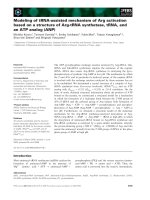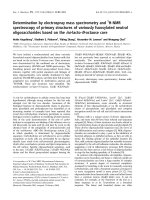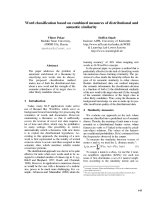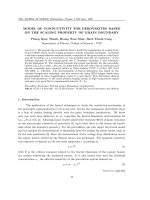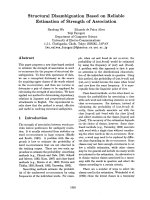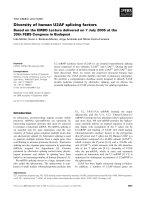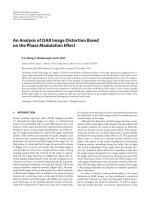Metaphor, based on the association of similarity, is one of the two basic types of semantic transference that have been an interest for many linguistic researchers
Bạn đang xem bản rút gọn của tài liệu. Xem và tải ngay bản đầy đủ của tài liệu tại đây (635.59 KB, 53 trang )
Part I: Introduction
1 Rationale
Metaphor, based on the association of similarity, is one of the two basic types of semantic
transference that have been an interest for many linguistic researchers. Galperin ( 1981: 139-40)
states that the term ‘metaphor’ can be understood as the transference of some quality from one
object to another. Metaphor is widely used to designate the process in which a word acquires a
derivative meaning.
In theory, there are at least three communicative functions that metaphor might serve (Ortony
1975). First, they might allow one to express that which is difficult or impossible to express if
one is restricted to literal uses of language. Evidence for this "inexpressibility" claim would
constitute encouraging support for the necessity-of-metaphors view. A second possible function
of metaphors is that they may constitute a particularly compact means of communication.
Although conscious experience is continuous in form, the linguistic system we use to talk about
it is comprised of discrete elements (lexical items). Unlike more literal forms of language,
metaphor may enable us to convey a great deal of information in a succinct manner by obviating
the need to isolate the predicates to be expressed into their corresponding lexical representations.
Finally, metaphors may help capture the vividness of phenomenal experience. If metaphors
convey chunks of information rather than discrete units, they can paint a richer and more
detailed picture of our subjective experience than might be expressed by literal language. This
we call the "'vividness" claim.
In this paper we are interested in the first and last of these possible functions. Thus, we need to
examine a discourse domain for which a prima facie case can be made for supposing that literal
language will often be inadequate and which lends itself to variations in vividness. There
doubtless are many such domains. The one that we selected was that of internal states, in
particular, emotional states. The literature on the linguistic expression of emotions suggests a
relatively high incidence of figurative language use (Davitz 1969), providing pragmatic reasons
An investigation into the role of metaphor in description of emotion in poetic discourse
1
for believing that the context of (linguistic) emotional expression may be a profitable one within
which to study metaphor production. Emotional states seemed well-suited because they tend to
have an elusive, transient quality that is difficult to describe using literal language, although, of
course, they can usually be labeled using literal language. Thus, while it might be easy for a
person to label an emotional state as, for example, "fear," it is difficult to provide a literal
description of the quality of some particular experience of fear. Furthermore, because emotions
vary in intensity, one might expect differential levels of vividness.
Our thesis is entitled “ An investigation into the role of metaphor in description of emotions
in English poetic disscourse” and focused on William Shakespeares’ sonnets. The choice is
based on two reasons. Firstly, recent research states that “Metaphorical modes of expression are
characteristic of all adult discourse”. Secondly, as stated above, the literature on the linguistic
expression of emotions suggests a relatively high incidence of figurative language use (Davitz
1969).
2 Aims of the study
This study aims to investigate the characteristics of metaphor in poetry from a systemic
functional perspective. The objective of the study is:
- To examine the characteristics of metaphor in poetry from the approach of Systemic
Functional Linguistics.
More details on the aimed objective of the study are discussed in Part 2, chapter 2-
Methodology.
3 Scope of the study
This study only attempts to explore metaphorical modes of expression of emotions in English
poetry discourse and takes William Shakespeares’ sonnets as an illustration due to their
available presence in the discourses.
Halliday (1994:341) states that: “ lexical selection is just one aspect of lexicogrammatical
selection, or wording; and that metaphorical variation is lexicogrammatical rather than simply
An investigation into the role of metaphor in description of emotion in poetic discourse
2
lexical”; basing on this the study will focus on grammatical metaphor or the way ideas are
expressed rather than on words used.
4 Methodology of the study
As the thesis sets its main objective of investigating the characteristics of metaphor in English
poetry discourse, it is descriptive research which begins with a phenomenon and seeks to
describe and explain it. The study was conducted in a deductive approach where data was
collected from English literature to describe metaphor as a natural linguistic process. The
techniques involved in data analysis are both qualitative and quantitative.
The concepts of metaphor and emotion was discussed in systemic functional and cognitive
approach respectively, and in comparison with other linguistic views in a linear line of time. The
emotion metaphors was retrieved from metaphor dictionaries and corpus data and analyzed with
respect to the use of it to convey emotion. Only metaphor that helps conceptualize emotions was
studied.
5 Organization of the study
The study is composed of three parts.
• Part 1: Introduction. This part introduces the relevance, the aims, the scope and the
methodology of the study.
• Part 2 : Development. This part consists of two chapters:
- Chapter 1: Literature review: provided the theoretical background of the study. Its focus
was on introducing important concepts relevant to the topic of the thesis. This chapter
gave a general picture of metaphor. The notion of emotion and how it is expressed in
poetry via metaphor was also taken into consideration.
- Chapter 2: The study: In this chapter, the research design applied in the study was
reported and the results of the study were presented.
An investigation into the role of metaphor in description of emotion in poetic discourse
3
• Part 3 is the conclusion of the study which summarized the issues addressed in the main
part and offered implications for teaching and further study.
An investigation into the role of metaphor in description of emotion in poetic discourse
4
PART II: DEVELOPMENT
CHAPTER 1: LITERATURE REVIEW
I. THEORETICAL BACKGROUND
1 Introduction
Language is a systematic resource for expressing meaning in context and linguistics, according
to Halliday (1985), is the study of how people exchange meanings through the use of language.
This view of language as a system for meaning potential implies that language is not a well
defined system, nor a "the set of all grammatical sentences." It also implies that language exists
and therefore must be studied in contexts such as professional settings, classrooms, and
language tests. This is the key concept expressed in the theory of Systemic Functional
Linguistics developed by Halliday (1985) and basing on it this chapter is concerned with some
of the concepts which set the theoretical background for the study of metaphor.
Since a great deal has already been written about the systemic function model, both from
practical and theoretical perspective ( Halliday 1994; Halliday & Hasan 1989; Martin 1985,
1992; Matthiessen 1995, Hoang Van Van 1997, Do Tuan Minh 2001 amongst many others) this
section will be restricted to a number of key points in the theories that are closely related to the
topic of the study- metaphor.
Our overview on the systemic functional linguistics is organized around the headings: Language
and Social Context, Levels of Context, Levels of Language, Metafunction, Instantiation, Rank
and Nominal Group.
2 Language and Social Context
Systemic Functional Grammar was established as a linguistic theory by M.A.K. Halliday. It is a
theory of language centred around the notion of language function. Halliday argues that it is the
social context for communication that regulates the way the semantics of language are
employed. He believes that social settings shape the development of language. The form of
An investigation into the role of metaphor in description of emotion in poetic discourse
5
human language is as it is since it co-evolves with the meanings which co-evolve with the
community’s contexts of social interaction.
Then, language and social is treated as complementary levels of semiosis related by the concept
of realization. We can illustrate the relationship between them by the image of co- tangential
circles as in figure 2.1
Figure 1 : Language as the Realization of Social Context
( Source: Halliday& Martin 1993:25)
3 Levels of Context
The interpretation of social context includes two levels of communication: genre (context of
culture) and register (context of situation) (Martin 1992: 495).
An investigation into the role of metaphor in description of emotion in poetic discourse
6
Social Context
Language
Extralinguistic
levels
Linguistic levels
Figure 2 ( Source: http//:wwww.uefap.com/courses/beacc/fsl/intro/htm)
The context of culture can be thought of as deriving from a combination of all of the genres
which make up a particular culture. Genres are the culturally evolved ways of achieving goals
that involve language. They are "staged, goal- oriented social processes" (Martin 1992: 505) in
which people engage as members of their culture. They are “social” because we participate in
genres with other people; goal-oriented because we use genres to get things done; staged
because it usually takes us a few steps to reach our goals" (Martin & Rose 2003: 7-8). Each
genre is therefore characterized by a distinctive schematic structure with a clear beginning,
middle and end through which the function of the genre is realized. These genres include all of
those routines from everyday experience such as purchase of goods (food, clothing etc), to the
genres of particular forms of social life including TV interviews, getting arrested etc. They also
include genres which are valued in education and business. Lectures are genres, as are seminars
and tutorials etc and written genres such as narratives, reports, explanations, procedures, and
expositions. These genres have their own distinctive structures (or well-established stages)
because of the social purposes they fulfill in the culture in which they are used. They occur in
particular situation types and it is the characteristics of this situation type that influence the
forms of language that realize the genre. So the context of situation (register) is the second
aspect of social context that influences the linguistic realization of the genre. This context of
An investigation into the role of metaphor in description of emotion in poetic discourse
7
situation of a text has been described by Halliday (Halliday and Hasan 1985: 12) in terms of the
variables of Field, Tenor and Mode.
+ The FIELD OF DISCOURSE concerns what is happening, to the nature of the social action
that is taking place: what is it that the participants are engaged in, in which the language is an
essential component?
+ The TENOR OF DISCOURSE concerns who is taking part, to the nature of the participants,
their statuses and roles: what kinds of role relationships obtain among the participants, including
permanent and temporary relationships of one kind or another, both the types of speech role that
they are taking on in the dialogue and the whole cluster of socially significant relationships in
which they are involved?
+ The MODE OF DISCOURSE concerns what part the language is playing, what it is that the
participants are expecting the language to do for them in that situation, the symbolic
organisation of the text, the status that it has, and its function in the context, including the
channel (is it spoken or written or some combination of the two?) and also the rhetorical mode,
what is being achieved by the text in terms of such categories as persuasive, expository, didactic
and the like.
Figure 3 Source: http//:wwww.uefap.com/courses/beacc/fsl/intro/htm on
An investigation into the role of metaphor in description of emotion in poetic discourse
8
4 Levels of Language
While SFL accounts for the syntactic structure of language, it places the function of language as
central (what language does, and how it does it), in preference to more structural approaches,
which place the elements of language and their combinations as central. SFL starts at social
context, and looks at how language both acts upon, and is constrained by, this social context.
Systemic Functional Grammar divides the language system into four strata: context, semantics,
lexico-grammar, and phonology/graphology. As shown in Fig. 2.4, each stratum can be further
divided into functional components or functions. Ideational, interpersonal and textual functions
of language are considered in the semantic stratum. Here, ideational meaning refers to the way
one uses representational tools to compose the idea. In the context stratum for example,
functional components are concerned with field (what is going on in the communication), tenor
(the social roles and relationships involved) and mode (the medium for communication).
Lexico-Grammar is a resource for putting meanings into words, i.e. realizing them as
configurations of lexical and grammatical items. It concerns the syntactic organization of words
into utterances, involving analysis of the utterance in terms of roles such as Actor, Agent,
Medium, Theme, Mood, etc. This gives Martin (1992:496):
Figure 4 Source: http//:wwww.uefap.com/courses/beacc/fsl/intro/htm on
5 Metafunctions, rank and the nominal group
An investigation into the role of metaphor in description of emotion in poetic discourse
9
5.1 Metafunctions
Central to SFL is the use of systems, used to represent the choices present in making an
utterance. The three systems related to the three metafunctions are: Transitivity,
Theme/Rheme and Mood & Modality. Ideational (experiential and logical) meanings
construing Field are realized Lexico-Grammatically by the system of Transitivity. This system
interprets and represents our experience of phenomena in the world by describing experiential
meanings in terms of participants, processes and circumstances. Interpersonal meanings are
realized Lexico-Grammatically by systems of Mood & Modality. The Mood system is the
central resource establishing an exchange between interactants by assuming and assigning
speech roles such as giving or demanding goods and services or information. Thus the giving of
information or goods and services is grammaticalized as declaratives, questions are
grammaticalized as interrogatives and commands as imperatives. Textual meanings are
concerned with the interaction of interpersonal and ideational information as text in context.
Lexico-Grammatically textual meanings are realized by systems of Theme/Rheme.
Theme/Rheme selections establish the orientation or angle on the interpersonal and ideational
concerns of the clause.
Figure 5 Source http//:www.uefap.com/cources/baecc/sfl/intro.htm
5. 2 Rank
An investigation into the role of metaphor in description of emotion in poetic discourse
10
Rank orders units into a hierarchy according to their constituency relation: the highest-ranking
units consist of units of the rank immediately below, these units consist of units at the next rank
below, and so on, until we arrive at the units of the lowest rank, which have no internal
constituent structure. Rank is thus a theory of the global distribution of the units of the grammar.
The English grammatical rank scale recognized by Systemic Functional Grammar is as follows:
In turn, each unit has their own members which are grouped into classes. For example, sentences
can be divided into nominal, verbal, adverbial and adjectival groups; noun, verb, adverbs, etc
belong to word.
The most important unit that functional grammar takes into consideration is clause. Analyzing
clause structure means identifying the functional parts of the clause from each of the three
different perspectives: ideational, interpersonal and textual. In each metafunction, an analysis of
a clause gives a different kind of structure composed from a different set of elements.
For example, in the ideational metafunction, a clause is analyzed into the functional parts as the
following:
An investigation into the role of metaphor in description of emotion in poetic discourse
Unit
sentence
clause
group/ phrase
word
morpheme
11
Chart 1 : Clause structure- ideational metafunction - four functional parts by Martin,
Matthiessen & Painter (1997: 7-8)
In textual metafunction, the clause is analyzed as Theme and Rheme. The above example can be
illustrated as follows:
Chart 2 : Clause structure- textual metafunction - four functional parts by Martin,
Matthiessen & Painter (1997: 7-8)
In English Theme is the first element of a clause and providing what we call the departure for
the starting point for the clause. By changing Theme we do not change the ideational meaning
but the textual meaning.
An investigation into the role of metaphor in description of emotion in poetic discourse
clause
Circumstance
participant Process Circumstance
Place
in her heart
Process
has grown
Actor
a secret love
Time
Lately
Clause
Theme
Lately
Rheme
a secret love has grown in her heart.
12
There is the third kind of meaning called interpersonal meaning which is realized by Mood and
Residue
Chart 3 : Clause structure- interpersonal metafunction - four functional parts by Martin,
Matthiessen & Painter (1997: 7-8)
5. 3 The nominal group
The metafunctional organization of the grammar that we illustrated above for the clause applies to the
other ranks as well. For example, the nominal group has ideational systems of THING TYPE,
CLASSIFICATION, EPITHESIS and QUALIFICATION, interpersonal systems of PERSON and
ATTITUDE, and textual systems of DETERMINATION. But the way the metafunctional
contributions map structurally one onto another varies; in particular, groups are organized both as
organic wholes and as logical complexes. The figure below shows an example of an English nominal
group.
Table 1: Experiential and logical analysis of the English nominal group
.
An investigation into the role of metaphor in description of emotion in poetic discourse
Clause
MOOD RESIDUE
Predicator
grown
Adjunct
in her heart
Adjunct
lately
Subject
A secret love
Finite
has
The two greatest professional golfers of all time
Deictic Numerative Epithet Classifier Thing Qualifier:
Minor
process
Minor
Range
13
6 Summary
In this chapter we have tried to give an overview of systemic functional linguistics. It is
described as a functional- semantic approach to language which explores how language is used
in different contexts, and how it is constructed for using as a semiotic system. Language and
context are viewed as complementary abstractions, related by the important concept of
realization. Context is realized by the content level of language ( semantics and lexico-grammar)
and content is given form in the expression level ( phonology or graphology). Then, the
semantics level is classified into three metafunctions( experiential, interpersonal and textual) and
each of them is related to a specific context or register variable ( field, tenor or mode) which
then is realized through one or more of the lexico-grammartical systems ( transitivity, mood or
theme). Another notion of SFL is rank- the hierarchical relationship between the various units of
language, has also been mentioned .
II. METAPHOR: A GENERAL DESCRIPTION
1 Introduction
The notion of meaning potential is central to a systemic description of language: there are many
things we can mean, and in order to communicate we choose from this range of potential
meanings. Therefore, a theory of language must be able to describe both the potential, and the
initiation of a choice from that potential. If the relationship between the meaning potential and
the realization of a choice was totally random, then language would be impossible to describe
An investigation into the role of metaphor in description of emotion in poetic discourse
14
and study, and probably useless as a communication tool. Evidently, the relationship is not
random. Halliday ( 1994:343) states that “ ... for any selection in meaning there will be a natural
sequence of steps leading towards its realization”.
2 Definition of metaphor
Traditionally, metaphor has been viewed as poetic or literary language. Nevertheless, in the last
few decades, cognitive linguists like, for example, Lakoff and Johnson have revealed that
metaphors play an important part in colloquial language and everyday use. Lakoff and Johnson
have found that “metaphor is conceptual system, in terms of which we both think and act, is
fundamentally metaphorical in nature” (1980: 3). Even though not all language is metaphorical,
metaphors are indeed an important part of language. (Saeed 2003: 247).
So how do we define metaphor? It is taken to be ( as the name suggests in Greek) a transfer of
some kind. We will mention some of the definitions of metaphor as follows.
A simplified definition is that metaphor is a “mapping of the structure of a source model onto a
target model” (Ungerer and Schmid 1999: 120). The source and the target domain of a metaphor
belong to two different cognitive domains. To complicate things these belong to different
superordinate domains and it has not yet been stated precisely what a domain is, neither when
one is different from another nor when exactly a domain is superordinate (Barcelona 2003: 32).
The basic claims of the cognitive account of metaphor, developed by Lakoff, Johnson and
Turner (Lakoff and Johnson 1980, Lakoff 1987, Lakoff and Turner 1989, Lakoff 1993), and
elaborated as a more general model of 'blending' by Turner and Fauconnier can be summarised
as follows (see Figure 7):
(1) Metaphor is a cognitive process in which one set of concepts (a target) is understood in terms
of another (a source). According to the model of blending, metaphor is a conceptual integration
of four (or more) mental spaces. Mental spaces are small conceptual arrays constructed for local
An investigation into the role of metaphor in description of emotion in poetic discourse
15
purposes of understanding. When a conceptual projection occurs, two input mental spaces
(source and target in a metaphor) are created. These input spaces have relevant information from
the respective domains, as well as additional structure from culture, context, point of view and
other background information.
Figure 7 Model of blending
Consider the following examples:
1. He has been swept out of her heart.
2. The sky is crying.
In the first example, swept out, which literally refers to a physical movement in which
something is removed from a certain place to another, is used to refer to the meaning “
dismissing as a lover”. In the second example, the action “ crying” is transferred to another
An investigation into the role of metaphor in description of emotion in poetic discourse
16
meaning as “ raining”. In both of the examples there is a transfer from a literal to a new,
figurative meaning. According to Lakoff and Johnson (1980) this is a metaphorical movement.
Amongst the conventional metaphor given by the cognitive linguistics we find the concept
EMOTION IS AS A PHYSICAL FORCE. In the view of cognitive linguistics the general
metaphor EMOTION IS AS A PHYSICAL FORCE is illustrated as follows:
EMOTION IS A PHYSICAL FORCE
ANGER IS HEAT: He was steaming. I thought he was going to explode.
Wait until you’ve cooled down.
LOVE IS HEAT: She positively glowed.
He gave me an icy stare.
Come on baby, light my fire.
LOVE IS (MAGNETIC) ATTRACTION: We’re poles apart. I keep being drawn back to her.
She turns heads wherever she goes.
ANXIETY IS A BURDEN: It’s been a great weight off my mind.
He had been labouring under that assumption for a long time.
Let me shoulder some of your worries for a while.
SADNESS IS A BURDEN: It’s weighing me down.
It’s the last straw (that broke the camel’s back).
I keep being dragged under.
On summary, many researchers have been working on giving out a definition of metaphor but
there has not been a universal one yet. One broad and better definition is given by Kleinginna
and Kleinginna (1981). They gathered, analyzed and classified 92 definitions and 9 skeptical
An investigation into the role of metaphor in description of emotion in poetic discourse
17
statements about the concept of emotion concluding that there is little consistency among
definitions and many are too vague. Therefore, the researchers suggested a comprehensive
definition as follows:
"Emotion is a complex set of interactions among subjective and objective factors,
mediated by neural/hormonal systems, which can:
(a) give rise to affective experiences such as feelings of arousal, pleasure/displeasure;
(b) generate cognitive processes such as emotionally relevant perceptual effects,
appraisals, labeling processes;
(c)activate widespread physiological adjustments to the arousing conditions; and
(d) lead to behavior that is often, but not always, expressive, goal directed, and adaptive"
(Kleinginna and Kleinginna 1981 p. 355).
So far we have discussed the metaphorical movement in lexical level, the changes happen to
words, and this is called lexical metaphor, a feature belongs to lexicon and refers to a change of
meaning to a new, figurative ones.
It is against the background of lexical metaphor, Michael Halliday , in the early 1980s, in his
work on Systemic Functional Linguistics, introduced the notion of grammatical metaphor which
we will discuss more thoroughly in the next session.
3 Grammatical Metaphor
As typical examples of grammatical metaphor, Halliday considers various types of
nominalization. Let us look at the following instances:
1. The fact that he failed in the exam surprised me.
2. His failure in the exam surprised me.
An investigation into the role of metaphor in description of emotion in poetic discourse
18
In order to see why examples such as (1) is not while (2) is grammatical metaphor, in Halliday’s
sense, we can take recourse to the notion of a metaphorical movement, which characterizes
metaphors in general, as we have seen in the previous section. In example (2), his failure in the
exam refers to a process taking place at a particular time in reality. Now, according to Halliday,
processes are normally expressed by means of a conjugated verb and a number of participants
taking part in the activity, with the verb and its participants together constituting a full clause. In
this view, the most straightforward encoding of the process referred to in (1). What exactly is
metaphorical, in an example such as (2), in Halliday’s view, is the fact that a process (a verb,
fail, and its participants, He + the exam) is not realized by means of a clause, but rather by
means of another type of form, such as a noun phrase, as in the example at hand. In this sense,
grammatical metaphor again involves a type of metaphorical movement: from a process as
clause (the default encoding of a process) to a process as noun phrase. Grammatical metaphor is
thus based on the variation between something common, standard, default (i.e. a process
realized as a clause) and something which is extended from that (i.e. a process realized by some
other form, e.g. a noun phrase), and in this sense grammatical metaphor is similar to the
traditional type of metaphor looked at above. However, in the case of grammatical metaphor, the
two aspects involved in the movement or metaphorical extension no longer refer to lexemes and
lexical meanings (as with lexical metaphor). Rather, they refer to grammatical forms, or
grammatical means of expression, such as a clause and a nominal group. According to Halliday,
grammatical metaphor is conceived as an incongruent realization of a given semantic
configuration in the lexicogrammar ( 1985: 321)
4 Classification of grammatical metaphor
In general, there are four kinds of grammartical metaphor: ideational (experiential),
interpersonal, , logical and. textual. They occur when the usual or ‘congruent’ realization of
meaning is given a ‘non congruent’ or metaphorical expression. The ideational grammatical
metaphor relates to the experiential meaning, the logical metaphor to the textual meaning and
the interpersonal metaphor to the interpersonal meaning.
4.1 Congruent realization of meaning
An investigation into the role of metaphor in description of emotion in poetic discourse
19
SFL describes the congruent form of representing experience like this:
Example 1: Congruent realization of meaning
(1) He is furious because his wife has been kidnapped.
In the following example we have a more incongruent form of representing reality through a
grammatical metaphor:
Example 2: Incongruent realization of meaning: grammatical metaphor
(2) He is in a flood of anger because his wife has been kidnapped.
Why consider this a metaphorical expression? The answer relies on the acceptance of the notion
that the congruent form is the unmarked way we represent experience and that the alternative or
marked realization is a form of metaphor.
Congruent Metaphorical
1. Adjective (Qualifier) Noun (Entity)
2. Verb (Process) Noun (Entity)
3. Verb (Process) Adjective (Qualifier)
4. Adverb (Circumstance) Adjective (Qualifier)
5.Conjunction (Relator) Prepositional Phrase ( Circumstance)
Table 2 - Class shift (semantic type)
( Adapted from Halliday 1995)
4.2 Logical grammatical metaphor
Logical grammatical metaphor refers to the consideration of meaning in an incongruent way at
the level of the organization of the discourse. The most congruent form of joining two ideas is
An investigation into the role of metaphor in description of emotion in poetic discourse
20
with a conjunction but when conjunctions are realized through processes and nouns allowing for
two or more clauses to become one, it is referred as a logical grammatical metaphor.
In spoken medium the logico-semantic relations such as cause-effect are more commonly
realized by conjunctions. This type of metaphor is called ‘ logical metaphor’ because it involves
what Martin (1993) calls ‘buried reasoning’, or the metaphorical realization of the logico-
semantic relations such as cause and effect that in a less metaphorical realization would be
expressed by the conjunctions. This metaphorical realization of conjunctive relations by
processes like ‘resulting’, ‘causing’, ‘depending’, etc. and nominal groups like ‘ classifier’,
‘qualifier’, ‘numerative’ , etc.
4. 3 Ideational grammatical metaphor
The examples given in 3, which are repeated here for ease of reference, have been described as
illustrating a metaphorical shift from process as clause to process as noun phrase:
1. His failure in the exam surprised me.
In the systemic functional model of language, the notion of a ‘process’ belongs to the ideational
metafunction: a ‘process’ is one aspect by which we represent and shape the reality we live in as
human beings. In the previous section, ‘process’ has been mentioned as complementary to other
ideational notions, viz. ‘entity’ and ‘quality’. With these notions in mind, the nature of the
metaphors in (1) and (2) can now be further explained. We have seen above that, in Halliday’s
view, a process is normally expressed by means of a clause, but it can metaphorically be
expressed by means of a noun phrase. What is important is that a noun phrase is also the
‘normal’ (i.e. default, standard) expression of some other ideational type of meaning, viz. an
entity. An entity is normally expressed by means of noun phrase: a table, the sun, my sister, joy,
eight books. In this sense, in example (1), the form ‘noun phrase’ is borrowed to metaphorically
express the meaning of a process, in the same sense as the lexica; in example (4) (repeated here)
borrows the lexeme grasp to express the meaning ‘understand’:
(4) He didn’t grasp it.
An investigation into the role of metaphor in description of emotion in poetic discourse
21
The form of a noun phrase can be borrowed to express processes (which are normally realized
by means of clauses), but it can also be used metaphorically to express qualities, which are by
default encoded by adjectives. In this sense, (6) is a metaphorical variant of (5).
(5) She is dishonest.
(6) You cannot really count on her honesty.
Another common sub-type of ideational metaphor is where a process (normally expressed by
means of clause) comes to be expressed by means of an adjective, and thus, comes to be
conceived of as a quality instead.
Ideational metaphor is a powerful resource in the grammar of a language, by which the
expression of ideational meanings such as processes, qualities and entities is extended in
important ways beyond their default encodings as clauses, adjectives and nouns (or noun
phrases) respectively: different forms can be borrowed to express different meanings.
4.4 .Interpersonal grammatical metaphor
The main function of the ideational grammatical metaphor is to condense the information as a
way to pack more lexical items in one clause at the expense of deleting the participants and time
of the processes, i.e. the ideational grammatical metaphor is a more metaphorical way of
expressing the meaning at the level of experience. The interpersonal grammatical metaphor, on
the other hand, can be described as a metaphorical way to express interpersonal meanings that
are congruently represented in mood and modality choices. The use of this kind of grammatical
metaphor is especially important in language as they allow for a more explicit or implicit
presence of the writer/speaker in the discourse
The interpersonal component of grammar especially concerns the areas of modality and mood.
In these two areas, Halliday also distinguishes between basic, non-metaphorical expressions, and
metaphorical ones, i.e. inter- personal metaphors. Let us look at each area in turn.
An investigation into the role of metaphor in description of emotion in poetic discourse
22
A default realization of a modal meaning, for example, a degree of certainty, according to
Halliday, is by means of modal elements that occur within the clause that is being modally
evaluated. For example, in order to express the likelihood of John having left already, we can
use a modal verb such as must (9) and/or a modal adverb such as certainly (10):
(9) John must have left (, because the lights are off).
(10) John will certainly have left by now.
Halliday calls these expressions of modality, which occur within the clause structure itself, the
basic type. However, the same meaning of likelihood with a high degree of certainty can also be
expressed by adding more elements to the initial clause John + have left. The following
examples illustrate just a few possibilities:
a. I think John has already left.
b. It is very likely that John has already left.
c. Everyone believed that John had already left.
d. It is clear that John has already left.
In each of the examples above, the modal meaning (i.e. a high degree of certainty that something
is the case) is expressed by elements which lie outside the original clause, and which are based
on particular types of verbs, such as think (a) or believe (c), or particular types of adjectives,
such as likely (b) or clear (d). Halliday calls such expressions interpersonal metaphors of
modality, because the modal meaning is realized outside the clause (in contrast with the standard
encoding by means of modal verbs or adverbs, which lie within the clause structure). In this
case, again, the metaphors are based on a borrowing: for example the verb think can be
borrowed to express a modal meaning, as in example (a).
The second interpersonal area in grammar, according to systemic functional linguistics, is that of
mood. In order to understand the notion of interpersonal metaphors of mood, it is necessary to
consider, again, what the default types of encoding are. With regard to mood, Halliday
distinguishes three major types of interactive functions: statements are expressions which give
An investigation into the role of metaphor in description of emotion in poetic discourse
23
information, questions are expressions which ask information, and commands are expressions
which ask for something to take place. Each of these functions has its standard, default type of
encoding: statements are encoded by the declarative, questions by the interrogative, and
commands by the imperative, as we have seen in examples (2)–(4) above. The expression of
statements and questions is fairly straightforward, but with regard to commands, the situation is
different. There is a large variety of expressions that can be used to express the same command:
(11) Send your proposal by email, please.
(12) a. Could you send your proposal by email, please ?
b. I would advise you to send it by email.
c. You are kindly requested to send your proposal by email.
d. It is recommended that you send your proposal by email.
e. It is advisable to send your proposal by email.
The examples in (11) are different metaphorical variants of expressing a command that can also
be expressed, in its most straightforward, standard way, as an imperative (11). The metaphorical
examples in (12) include the interrogative mood type (which is the standard expression of
requests for information), and the declarative mood type (which normally, i.e. non-
metaphorically, expresses the speech function of giving information). Halliday brings together
these various expressions under the heading of the notion of interpersonal metaphor of mood.
The reason why these examples are regarded as metaphorical, lies in the fact that they deviate
from the standard, most straightforward realization of a command by means of the imperative
mood. Their metaphorical nature can be made clear by pointing to the literal meanings that these
expressions have. For instance, (12a), at face-value, is basically a request for information: ‘could
you send your proposal by email, or couldn’t you’? Similarly, at face-value, (12b) only refers to
a statement: I state that I advise something to you.
The metaphorical nature of such metaphors of mood is exploited in verbal play. A case in point
is the well-known dinner-table example, where someone asks: Can you pass me the salt, please?,
An investigation into the role of metaphor in description of emotion in poetic discourse
24
and the addressee answers, ‘Yes, I could certainly do that’, without undertaking any further
action with regard to the salt.
4.5 Textual grammatical metaphor
Halliday (1994) does not include this kind of grammatical metaphor in his stydy. Martin (1992)
is the only systemic scholar who deals with metaphor from the textual perspective. He states that
“ grammatical metaphor affects both the ideational and textual structure of the clause since it is a
tool for organizing text” ( martin in Halliday & Martin 1993: 41) He believes that textual
metaphors are logically oriented – they provide source for metaphorical realization of
conjunctive relations:
Meta-message relation: reason, factor, pointing out ...
Text reference: this
Negotiating texture: let me begin by...
Internal conjunction: A number of reasons, for example, as a result....
5 Nominalization
5.1 Taking process as thing
In the congruent form of realization, a process should be realized by a verb. But in the
incongruent form, a process can be represented as a thing, as in:
[1a] First, she reviewed how the dorsal fin evolved.
[1b] There was a first review of the evolution of the dorsal fin.
This kind of metaphor has three functions. First, it can turn a dynamic process into a static entity
through recategorization and provides us with a different way of construing the world. Second, it
can increase the information load of the nominal group by nominalizing the dynamic process
and putting several epithets before the head of the nominal group, and thus succeeds in
condensing the information of the clause. Third, it can blur or cover up the actor by using
nominalizations.
An investigation into the role of metaphor in description of emotion in poetic discourse
25

